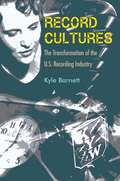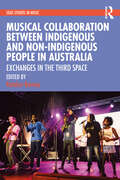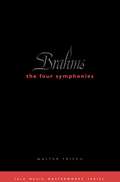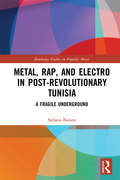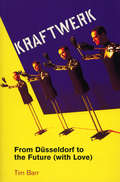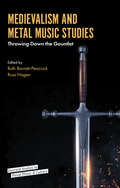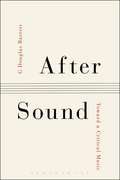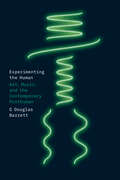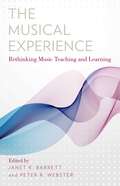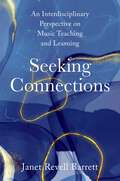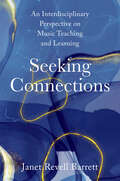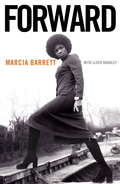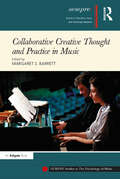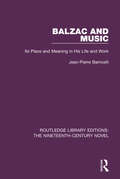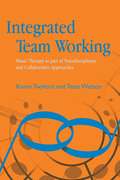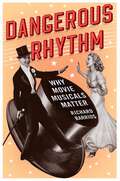- Table View
- List View
Record Cultures: The Transformation of the U.S. Recording Industry
by Kyle BarnettRecord Cultures tells the story of how early U.S. commercial recording companies captured American musical culture in a key period in both music and media history. Amid dramatic technological and cultural changes of the 1920s and 1930s, small recording companies in the United States began to explore the genres that would later be known as jazz, blues, and country. Smaller record labels, many based in rural or out of the way Midwestern and Southern towns, were willing to take risks on the country’s regional vernacular music as a way to compete with more established recording labels. Recording companies’ relationship with radio grew closer as both industries were on the rise, propelled by new technologies. Radio, which had become immensely popular, began broadcasting more recorded music in place of live performances, and this created profitable symbiosis. With the advent of the talkies, the film industry completed the media trifecta. The novelty of recorded sound was replacing film accompanists, and the popularity of movie musicals solidified film’s connections with the radio and recording industries. By the early 1930s, the recording industry had gone from being part of the largely autonomous phonograph industry to being major media industry of its own, albeit deeply tied to—and, in some cases, owned by—the radio and film industries. The triangular relationships between these media industries marked the first major entertainment and media conglomerates in U.S. history. Through an interdisciplinary and intermedial approach to recording industry history, Record Cultures creates new connections between different strands of media research. It will be of interest to scholars of popular music, media studies, sound studies, American culture, and the history of film, television, and radio.
Musical Collaboration Between Indigenous and Non-Indigenous People in Australia: Exchanges in The Third Space (SOAS Studies in Music)
by Katelyn BarneyThis book demonstrates the processes of intercultural musical collaboration and how these processes contribute to facilitating positive relationships between Indigenous and non-Indigenous peoples in Australia. Each of the chapters in this edited collection examines specific examples in diverse contexts, and reflects on key issues that underpin musical exchanges, including the benefits and challenges of intercultural music making. The collection demonstrates how these musical collaborations allow Indigenous and non-Indigenous people to work together, to learn from each other, and to improve and strengthen their relationships. The metaphor of the “third space” of intercultural music making is interwoven in different ways throughout this volume. While focusing on Indigenous Australian/non-Indigenous intercultural musical collaboration, the book will be of interest globally as a resource for scholars and postgraduate students exploring intercultural musical communication in countries with histories of colonisation, such as New Zealand and Canada.
Musical Collaboration Between Indigenous and Non-Indigenous People in Australia: Exchanges in The Third Space (SOAS Studies in Music)
by Katelyn BarneyThis book demonstrates the processes of intercultural musical collaboration and how these processes contribute to facilitating positive relationships between Indigenous and non-Indigenous peoples in Australia. Each of the chapters in this edited collection examines specific examples in diverse contexts, and reflects on key issues that underpin musical exchanges, including the benefits and challenges of intercultural music making. The collection demonstrates how these musical collaborations allow Indigenous and non-Indigenous people to work together, to learn from each other, and to improve and strengthen their relationships. The metaphor of the “third space” of intercultural music making is interwoven in different ways throughout this volume. While focusing on Indigenous Australian/non-Indigenous intercultural musical collaboration, the book will be of interest globally as a resource for scholars and postgraduate students exploring intercultural musical communication in countries with histories of colonisation, such as New Zealand and Canada.
Brahms: The Four Symphonies (PDF)
by Beth Baron"Walter Frisch provides a sensitive analytical commentary on the symphonies as well as a consideration of their place within Brahms's oeuvre, within the symphonic repertory of his day, and within the broader musical culture of nineteenth-century Germany and Austria. Frisch also pays particular attention to the evolution of performance style, describing how orchestra size, playing techniques, tempi, and articulation have changed since Brahms's symphonies were first heard."--BOOK JACKET
Metal, Rap, and Electro in Post-Revolutionary Tunisia: A Fragile Underground (Routledge Studies in Popular Music)
by Stefano BaroneMetal, Rap, and Electro in Tunisia is a trip into the music scenes of Tunisia after the Arab Springs. Based on extensive field research, the book explores the social life of heavy metal, rap, and electronic music in a North African country whose mass revolution of 2010/2011 led the way to a troubled and yet unique democracy. What is it like to be part of a music scene in a place affected by poverty and inequality? How do the many conflicted souls of Tunisian Islam shape local metal, rap, and electro? What are the social and cultural stakes for music in a nation constantly represented as a bridge between Europe and the Middle East? How do music scenes articulate the complex political scenario that followed the Tunisian revolution of 2011? Barone answers these questions by offering new theoretical reflections on youth cultures and popular music in a global perspective, and thus pushing the debate on "post-subcultures" and scenes forward. At the same time, the book offers a dense sociological analysis of youth and music in reality - the Tunisian one - whose society, culture, religion, and politics are at stake in a historical transformation.
Metal, Rap, and Electro in Post-Revolutionary Tunisia: A Fragile Underground (Routledge Studies in Popular Music)
by Stefano BaroneMetal, Rap, and Electro in Tunisia is a trip into the music scenes of Tunisia after the Arab Springs. Based on extensive field research, the book explores the social life of heavy metal, rap, and electronic music in a North African country whose mass revolution of 2010/2011 led the way to a troubled and yet unique democracy. What is it like to be part of a music scene in a place affected by poverty and inequality? How do the many conflicted souls of Tunisian Islam shape local metal, rap, and electro? What are the social and cultural stakes for music in a nation constantly represented as a bridge between Europe and the Middle East? How do music scenes articulate the complex political scenario that followed the Tunisian revolution of 2011? Barone answers these questions by offering new theoretical reflections on youth cultures and popular music in a global perspective, and thus pushing the debate on "post-subcultures" and scenes forward. At the same time, the book offers a dense sociological analysis of youth and music in reality - the Tunisian one - whose society, culture, religion, and politics are at stake in a historical transformation.
Kraftwerk: from Dusseldorf to the Future With Love
by Tim BarrThe future of modern music began in Dusseldorf in 1970, when an avant-garde German band, the Organisation re-invented themselves as Kraftwerk and set in motion a train of events which introduced a whole new language into popular culture. By pre-dating electro, house, ambient and techno by more than two decades, they are quite simply the most influentual band of the late 20th century. Having studied composi-tional theory at the Dusseldorf Conservatory, they have more in common with Stockhausen and Russian Constructivism than Chuck Berry and Andy Warhol and yet, in creating classic pop hits like 'Autobahn', 'Trans Europe Express', 'The Model' and 'Tour de France' Kraftwork created a mass-market blueprint. The list of those directly and profoundly influenced is staggering: Bowie & Iggy Pop; Human League; disco (Giorgio Moroder`s seminal work with Donna Summer); Gary Numan: Sparks; Simple Minds; Orbital; Underworld; in fact, ALL modern Dance music. As well as telling the tale of this famously enigmatic and reclusive group, Tim Barr will also speak to the full range of musicians who have been touched by Kraftwerk`s extraordinary influence.
Medievalism and Metal Music Studies: Throwing Down the Gauntlet (Emerald Studies in Metal Music and Culture)
by Ruth Barratt-Peacock Ross HagenMetal music has long nurtured an obsession with visions of the Middle Ages, with countless album covers and lyric sheets populated by Vikings, knights, wizards, and castles. Medievalism and Metal Music Studies: Throwing down the Gauntlet addresses this fascination with all things medieval, exploring how metal musicians and fans find inspiration both in authentically medieval materials and neomedievalist depictions of the period in literature, cinema, and other media. Within metal music, the medieval takes on multiple, and even contradictory meanings, becoming at once a cipher of difference and grotesque alterity while simultaneously being imagined as a simpler, more authentic time, as opposed to the complexities and stresses of modernity. In this fashion, the medieval period becomes both a source for artistic creativity and a vector for countercultural social and political critique. The contributors in this book hail from a wide range of fields including medieval history, music performance, musicology, media studies, and literature, and computer linguistics, bringing a variety of critical perspectives to bear on the topic. Engaging in analyses of cover art, liner notes, lyrics, and musical style, the contributors investigate issues of research methodologies, crucial concerns over identity and nationalism, and the recontextualisation of historical materials, all aimed at critically examining how and why medievalism has permeated heavy metal music and culture. Hearken to our tales!
Medievalism and Metal Music Studies: Throwing Down the Gauntlet (Emerald Studies in Metal Music and Culture)
by Ruth Barratt-Peacock Ross HagenMetal music has long nurtured an obsession with visions of the Middle Ages, with countless album covers and lyric sheets populated by Vikings, knights, wizards, and castles. Medievalism and Metal Music Studies: Throwing down the Gauntlet addresses this fascination with all things medieval, exploring how metal musicians and fans find inspiration both in authentically medieval materials and neomedievalist depictions of the period in literature, cinema, and other media. Within metal music, the medieval takes on multiple, and even contradictory meanings, becoming at once a cipher of difference and grotesque alterity while simultaneously being imagined as a simpler, more authentic time, as opposed to the complexities and stresses of modernity. In this fashion, the medieval period becomes both a source for artistic creativity and a vector for countercultural social and political critique. The contributors in this book hail from a wide range of fields including medieval history, music performance, musicology, media studies, and literature, and computer linguistics, bringing a variety of critical perspectives to bear on the topic. Engaging in analyses of cover art, liner notes, lyrics, and musical style, the contributors investigate issues of research methodologies, crucial concerns over identity and nationalism, and the recontextualisation of historical materials, all aimed at critically examining how and why medievalism has permeated heavy metal music and culture. Hearken to our tales!
After Sound: Toward a Critical Music
by G Douglas BarrettAfter Sound considers contemporary art practices that reconceive music beyond the limitation of sound. This book is called After Sound because music and sound are, in Barrett's account, different entities. While musicology and sound art theory alike typically equate music with pure instrumental sound, or absolute music, Barrett posits music as an expanded field of artistic practice encompassing a range of different media and symbolic relationships. The works discussed in After Sound thus use performance, text scores, musical automata, video, social practice, and installation while they articulate a novel aesthetic space for a radically engaged musical practice. Coining the term "critical music," this book examines a diverse collection of art projects which intervene into specific political and philosophical conflicts by exploring music's unique historical forms. Through a series of intimate studies of artworks surveyed from the visual and performing arts of the past ten years-Pussy Riot, Ultra-red, Hong-Kai Wang, Peter Ablinger, Pauline Boudry and Renate Lorenz, and others-After Sound offers a significant revision to the way we think about music. The book as a whole offers a way out of one of the most vexing deadlocks of contemporary cultural criticism: the choice between a sound art effectively divorced from the formal-historical coordinates of musical practice and the hermetic music that dominates new music circles today.
After Sound: Toward a Critical Music
by G Douglas BarrettAfter Sound considers contemporary art practices that reconceive music beyond the limitation of sound. This book is called After Sound because music and sound are, in Barrett's account, different entities. While musicology and sound art theory alike typically equate music with pure instrumental sound, or absolute music, Barrett posits music as an expanded field of artistic practice encompassing a range of different media and symbolic relationships. The works discussed in After Sound thus use performance, text scores, musical automata, video, social practice, and installation while they articulate a novel aesthetic space for a radically engaged musical practice. Coining the term "critical music," this book examines a diverse collection of art projects which intervene into specific political and philosophical conflicts by exploring music's unique historical forms. Through a series of intimate studies of artworks surveyed from the visual and performing arts of the past ten years-Pussy Riot, Ultra-red, Hong-Kai Wang, Peter Ablinger, Pauline Boudry and Renate Lorenz, and others-After Sound offers a significant revision to the way we think about music. The book as a whole offers a way out of one of the most vexing deadlocks of contemporary cultural criticism: the choice between a sound art effectively divorced from the formal-historical coordinates of musical practice and the hermetic music that dominates new music circles today.
Experimenting the Human: Art, Music, and the Contemporary Posthuman
by G Douglas BarrettAn engaging argument about what experimental music can tell us about being human. In Experimenting the Human, G Douglas Barrett argues that experimental music speaks to the contemporary posthuman, a condition in which science and technology decenter human agency amid the uneven temporality of postwar global capitalism. Time moves forward for some during this period, while it seems to stand still or even move backward for others. Some say we’re already posthuman, while others endure the extended consequences of never having been considered fully human in the first place. Experimental music reflects on this state, Barrett contends, through its interdisciplinary involvements in postwar science, technology, and art movements. Rather than pursuing the human's beyond, experimental music addresses the social and technological conditions that support such a pursuit. Barrett locates this tendency of experimentalism throughout its historical entanglements with cybernetics, and in his intimate analysis of Alvin Lucier’s neurofeedback music, Pamela Z’s BodySynth performances, Nam June Paik’s musical robotics, Pauline Oliveros’s experiments with radio astronomy, and work by Laetitia Sonami, Yasunao Tone, and Jerry Hunt. Through a unique meeting of music studies, media theory, and art history, Experimenting the Human provides fresh insights into what it means to be human.
Experimenting the Human: Art, Music, and the Contemporary Posthuman
by G Douglas BarrettAn engaging argument about what experimental music can tell us about being human. In Experimenting the Human, G Douglas Barrett argues that experimental music speaks to the contemporary posthuman, a condition in which science and technology decenter human agency amid the uneven temporality of postwar global capitalism. Time moves forward for some during this period, while it seems to stand still or even move backward for others. Some say we’re already posthuman, while others endure the extended consequences of never having been considered fully human in the first place. Experimental music reflects on this state, Barrett contends, through its interdisciplinary involvements in postwar science, technology, and art movements. Rather than pursuing the human's beyond, experimental music addresses the social and technological conditions that support such a pursuit. Barrett locates this tendency of experimentalism throughout its historical entanglements with cybernetics, and in his intimate analysis of Alvin Lucier’s neurofeedback music, Pamela Z’s BodySynth performances, Nam June Paik’s musical robotics, Pauline Oliveros’s experiments with radio astronomy, and work by Laetitia Sonami, Yasunao Tone, and Jerry Hunt. Through a unique meeting of music studies, media theory, and art history, Experimenting the Human provides fresh insights into what it means to be human.
The Musical Experience: Rethinking Music Teaching and Learning
by Janet R. Barrett Peter R. WebsterThe Musical Experience proposes a new concept - musical experience - as the most effective framework for navigating the shifting terrain of educational policy as it is applied to music education. The editors and contributors define musical experience as being characterized by the depth of affective and emotional responses that music generates. The chapters map out the primary forms of musical engagement - performing, listening, improvising, and composing - as activities which play a key role in classroom teaching. They also address the cultural scope of musical experience, which calls for the consideration of time, place, beliefs, and values to be placed upon musical activities. The Musical Experience discusses how music teachers can most effectively rely on means of musical communication to lead students toward the development and refinement of musical skills, understandings, and expression in educational settings. This book serves to expand upon the dimensions of musical experience and provides, from the forefront of the field, an integrated yet panoramic view of the educational processes involved in music teaching and learning.
Seeking Connections: An Interdisciplinary Perspective on Music Teaching and Learning
by Janet Revell BarrettMusic connects the lives of students, teachers, and school communities in many ways. Music is also integrally related to other art forms, history, culture, and other subjects commonly taught in schools. These relationships deserve critical attention, particularly as educators seek to reorient their curricula and pedagogy toward the pressing aims of social justice. Seeking Connections encourages interdisciplinarity as a capacity to be exercised-an orientation or habit of mind that teachers and students can develop. This capacity depends upon viewing music as permeable, recognizing that music influences related ways of knowing, just as related ways of knowing influence music. This book invites teachers to create educational experiences that engage students in exploring an expansive relationship with music. With imaginative examples drawn from diverse musical genres, visual art, poetry, and historical cases, Seeking Connections provides thoughtful principles, models, and instructional strategies to deepen students' understandings of musical works and inspire interdisciplinary inquiry throughout elementary and secondary music programs, as well as settings in music teacher education and professional development.
Seeking Connections: An Interdisciplinary Perspective on Music Teaching and Learning
by Janet Revell BarrettMusic connects the lives of students, teachers, and school communities in many ways. Music is also integrally related to other art forms, history, culture, and other subjects commonly taught in schools. These relationships deserve critical attention, particularly as educators seek to reorient their curricula and pedagogy toward the pressing aims of social justice. Seeking Connections encourages interdisciplinarity as a capacity to be exercised-an orientation or habit of mind that teachers and students can develop. This capacity depends upon viewing music as permeable, recognizing that music influences related ways of knowing, just as related ways of knowing influence music. This book invites teachers to create educational experiences that engage students in exploring an expansive relationship with music. With imaginative examples drawn from diverse musical genres, visual art, poetry, and historical cases, Seeking Connections provides thoughtful principles, models, and instructional strategies to deepen students' understandings of musical works and inspire interdisciplinary inquiry throughout elementary and secondary music programs, as well as settings in music teacher education and professional development.
Forward: My Life With and Without Boney M.
by Marcia BarrettComing to London aged thirteen from desperate poverty in Jamaica; pregnant at fifteen; fifteen years later singing in Boney M, one of the biggest international groups of the late-1970s; a messy group split during the 1980s; a 1990s solo career interrupted by six bouts of cancer - ovarian, breast, lymph node (twice), spine and oesophagus - and having to learn to walk again. Yet throughout Marcia Barrett has remained totally cheerful, relentlessly optimistic and a shining inspiration, looking on every obstacle as a mere inconvenience rather than anything insurmountable. Now, she is ready to tell her fantastic story, which is much more than just a pop star autobiography. It is a charming, candid, laugh-out-loud story of survival, triumph, indomitable spirit and total upfullness, often driven by sheer force of will. It is a feelgood story which will resonate amongst all.
Collaborative Creative Thought and Practice in Music (SEMPRE Studies in The Psychology of Music)
by Margaret S. BarrettThe notion of the individual creator, a product in part of the Western romantic ideal, is now troubled by accounts and explanations of creativity as a social construct. While in collectivist cultures the assimilation (but not the denial) of individual authorship into the complexities of group production and benefit has been a feature, the notion of the lone individual creator has been persistent. Systems theories acknowledge the role of others, yet at heart these are still individual views of creativity - focusing on the creative individual drawing upon the work of others rather than recognizing the mutually constitutive elements of social interactions across time and space. Focusing on the domain of music, the approach taken in this book falls into three sections: investigations of the people, processes, products, and places of collaborative creativity in compositional thought and practice; explorations of the ways in which creative collaboration provides a means of crossing boundaries between disciplines such as music performance and musicology; and studies of the emergence of creative thought and practice in educational contexts including that of the composer and the classroom. The volume concludes with an extended chapter that reflects on the ways in which the studies reported advance understandings of creative thought and practice. The book provides new perspectives to our understandings of the role of collaborative thought and processes in creative work across the domain of music including: composition, musicology, performance, music education and music psychology.
Collaborative Creative Thought and Practice in Music (SEMPRE Studies in The Psychology of Music)
by Margaret S. BarrettThe notion of the individual creator, a product in part of the Western romantic ideal, is now troubled by accounts and explanations of creativity as a social construct. While in collectivist cultures the assimilation (but not the denial) of individual authorship into the complexities of group production and benefit has been a feature, the notion of the lone individual creator has been persistent. Systems theories acknowledge the role of others, yet at heart these are still individual views of creativity - focusing on the creative individual drawing upon the work of others rather than recognizing the mutually constitutive elements of social interactions across time and space. Focusing on the domain of music, the approach taken in this book falls into three sections: investigations of the people, processes, products, and places of collaborative creativity in compositional thought and practice; explorations of the ways in which creative collaboration provides a means of crossing boundaries between disciplines such as music performance and musicology; and studies of the emergence of creative thought and practice in educational contexts including that of the composer and the classroom. The volume concludes with an extended chapter that reflects on the ways in which the studies reported advance understandings of creative thought and practice. The book provides new perspectives to our understandings of the role of collaborative thought and processes in creative work across the domain of music including: composition, musicology, performance, music education and music psychology.
Balzac and Music: Its Place and Meaning in His Life and Work (Routledge Library Editions: The Nineteenth-Century Novel)
by Jean-Pierre BarricelliFirst published in 1990, this book was the first comprehensive study of Balzac’s relationship to music, blending past scholarship with new perspectives to formulate an inclusive account. It begins by examining the contacts and experiences that shaped the musical side of Balzac’s life. These left valuable and lasting impressions which often found their way into his writings, where he recorded a myriad of critical and musicological opinions — assessed primarily in relation to Gambara and Massimilla Doni. These discussions prepare the way for an analysis of Balzac two major musical persuasions: religious music and Beethoven. This book will be of interest to students of literature and music.
Balzac and Music: Its Place and Meaning in His Life and Work (Routledge Library Editions: The Nineteenth-Century Novel)
by Jean-Pierre BarricelliFirst published in 1990, this book was the first comprehensive study of Balzac’s relationship to music, blending past scholarship with new perspectives to formulate an inclusive account. It begins by examining the contacts and experiences that shaped the musical side of Balzac’s life. These left valuable and lasting impressions which often found their way into his writings, where he recorded a myriad of critical and musicological opinions — assessed primarily in relation to Gambara and Massimilla Doni. These discussions prepare the way for an analysis of Balzac two major musical persuasions: religious music and Beethoven. This book will be of interest to students of literature and music.
Integrated Team Working: Music Therapy as part of Transdisciplinary and Collaborative Approaches (PDF)
by Alison Barrington Ann Sloboda Ann Woodward Claire Miller Claire Molyneux Jackie Lindeck Julie Sutton Karen Twyford Maria Radoje Nicky O'Neill Paula Hedderly Rachel Darnley-Smith Rachel Millman Rebecca O'Connor Roseanne Tyas Sally Watson Tessa Watson Wendy MageeIntegrated Team Working describes collaborative multidisciplinary approaches and demonstrates that they can be valuable methods of music therapy intervention. The authors explain the development of the music therapist's role within the multidisciplinary team and discuss the prevalence of collaborative partnerships between UK music therapists and other professionals such as occupational therapists, speech and language therapists, psychologists, physiotherapists and other arts therapists. They examine the rationale, purpose and application of collaborative approaches and explore how and why music therapists adopt these approaches at differing levels. The book includes case studies from a variety of clinical settings, which illustrate the creative and innovative approaches used in transdisciplinary work in the evolving discipline of music therapy. This theoretical and practical guide offers useful advice for music therapy students and professionals who wish to employ collaborative approaches. It will also be helpful for other professionals who are considering or already working together with music therapists.
Dangerous Rhythm: Why Movie Musicals Matter
by Richard BarriosSingin' in the Rain, The Sound of Music, Camelot--love them or love to hate them, movie musicals have been a major part of all our lives. They're so glitzy and catchy that it seems impossible that they could have ever gone any other way. But the ease in which they unfold on the screen is deceptive. Dorothy's dream of finding a land "Somewhere Over the Rainbow" was nearly cut, and even a film as great as The Band Wagon was, at the time, a major flop. In Dangerous Rhythm: Why Movie Musicals Matter, award winning historian Richard Barrios explores movie musicals from those first hits, The Jazz Singer and Broadway Melody, to present-day Oscar winners Chicago and Les Misérables. History, film analysis, and a touch of backstage gossip combine to make Dangerous Rhythm a compelling look at musicals and the powerful, complex bond they forge with their audiences. Going behind the scenes, Barrios uncovers the rocky relationship between Broadway and Hollywood, the unpublicized off-camera struggles of directors, stars, and producers, and all the various ways by which some films became our most indelible cultural touchstones -- and others ended up as train wrecks. Not content to leave any format untouched, Barrios examines animated musicals and popular music with insight and enthusiasm. Cartoons have been intimately connected with musicals since Steamboat Willie. Disney's short Silly Symphonies grew into the instant classic Snow White, which paved the way for that modern masterpiece, South Park: Bigger, Longer, & Uncut. Without movie musicals, Barrios argues, MTV would have never existed. On the flip side, without MTV we might have been spared Evita. Informed, energetic, and humorous, Dangerous Rhythm is both an impressive piece of scholarship and a joy to read.
Dangerous Rhythm: Why Movie Musicals Matter
by Richard BarriosSingin' in the Rain, The Sound of Music, Camelot--love them or love to hate them, movie musicals have been a major part of all our lives. They're so glitzy and catchy that it seems impossible that they could have ever gone any other way. But the ease in which they unfold on the screen is deceptive. Dorothy's dream of finding a land "Somewhere Over the Rainbow" was nearly cut, and even a film as great as The Band Wagon was, at the time, a major flop. In Dangerous Rhythm: Why Movie Musicals Matter, award winning historian Richard Barrios explores movie musicals from those first hits, The Jazz Singer and Broadway Melody, to present-day Oscar winners Chicago and Les Misérables. History, film analysis, and a touch of backstage gossip combine to make Dangerous Rhythm a compelling look at musicals and the powerful, complex bond they forge with their audiences. Going behind the scenes, Barrios uncovers the rocky relationship between Broadway and Hollywood, the unpublicized off-camera struggles of directors, stars, and producers, and all the various ways by which some films became our most indelible cultural touchstones -- and others ended up as train wrecks. Not content to leave any format untouched, Barrios examines animated musicals and popular music with insight and enthusiasm. Cartoons have been intimately connected with musicals since Steamboat Willie. Disney's short Silly Symphonies grew into the instant classic Snow White, which paved the way for that modern masterpiece, South Park: Bigger, Longer, & Uncut. Without movie musicals, Barrios argues, MTV would have never existed. On the flip side, without MTV we might have been spared Evita. Informed, energetic, and humorous, Dangerous Rhythm is both an impressive piece of scholarship and a joy to read.
